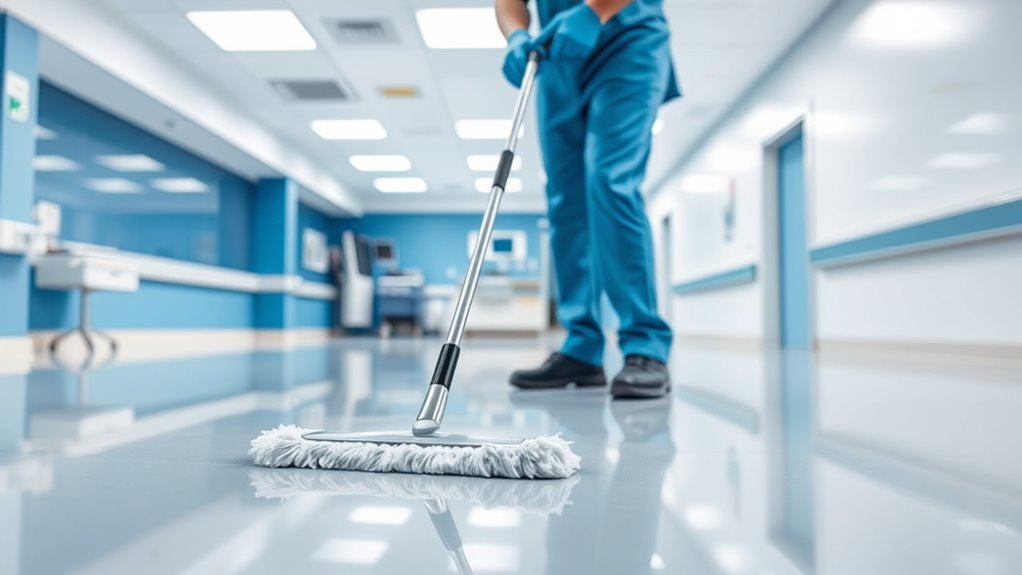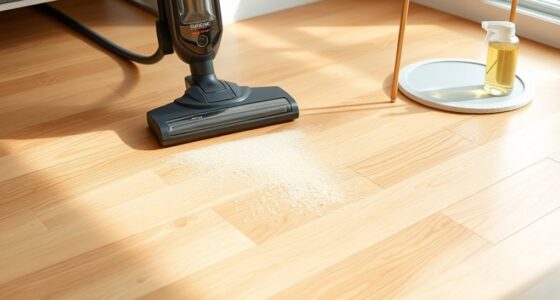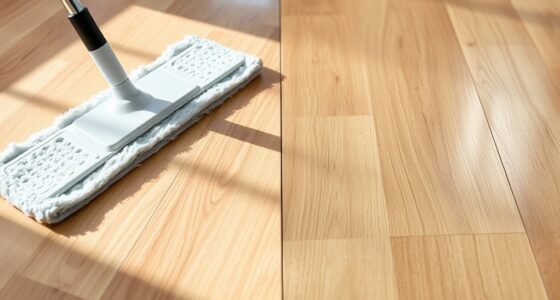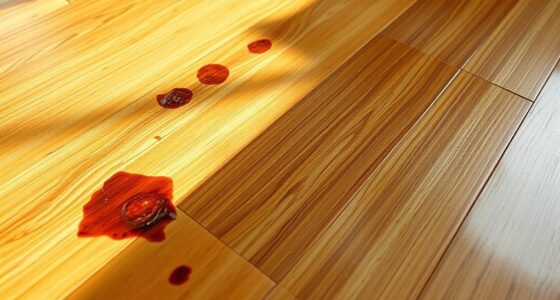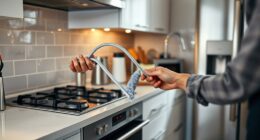To sanitize floors in healthcare settings, start by choosing an effective disinfectant approved for medical use. Use microfiber mops and cloths for better cleaning, and follow the manufacturer’s instructions for preparing solutions. Clean high-touch areas and corners regularly, especially in high-traffic zones, and allow disinfectants to air dry for proper contact time. Maintaining a consistent cleaning schedule and ensuring staff are well-trained are essential for infection control; keep going to learn more about best techniques.
Key Takeaways
- Follow established disinfection protocols by selecting appropriate hospital-grade disinfectants and ensuring proper contact time.
- Use microfiber mops and cloths to effectively trap dirt and microbes during cleaning.
- Clean high-traffic areas multiple times daily and less frequent zones at regular intervals to prevent microbial buildup.
- Train staff regularly on proper cleaning techniques, disinfectant preparation, and adherence to safety standards.
- Allow disinfectants to air dry completely to ensure maximum pathogen elimination and prevent cross-contamination.
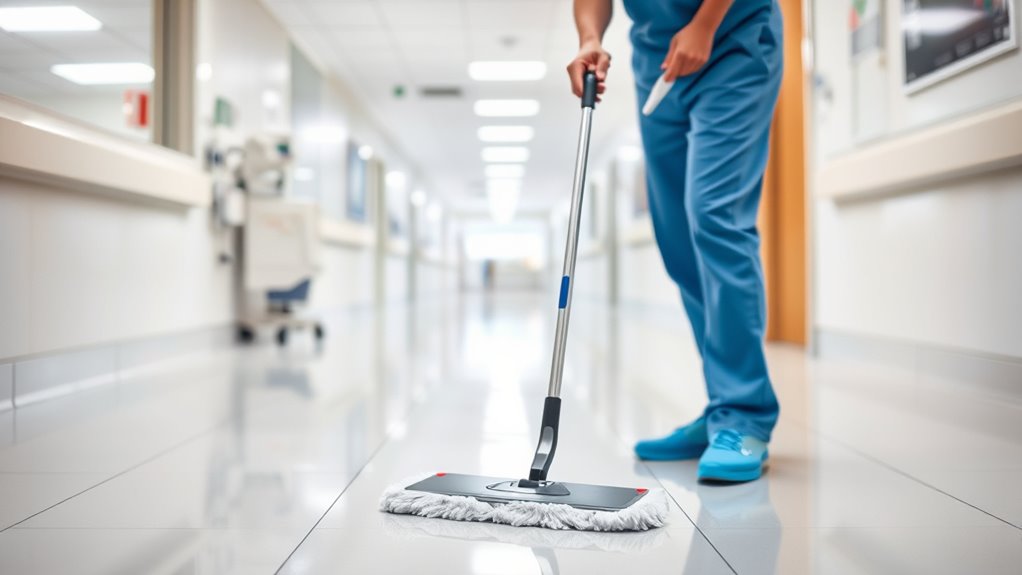
Have you ever contemplated how critical sanitized floors are in healthcare settings? They’re more than just a surface you walk on; they’re a frontline defense against the spread of infections. Proper sanitation begins with understanding and implementing effective disinfection protocols. These protocols act as a structured plan, outlining the specific cleaning agents, tools, and procedures necessary to eliminate pathogens from the floors. When you follow a well-designed disinfection protocol, you ensure consistency and thoroughness, reducing the risk of cross-contamination. The protocols should specify the types of disinfectants suitable for healthcare environments, how to prepare cleaning solutions, and the contact time required for maximum effectiveness. By adhering to these detailed steps, you can significantly lower the microbial load on floors, safeguarding both patients and staff.
Cleaning frequency is another essential aspect you need to take into account. In healthcare settings, floors aren’t just walked on—they’re exposed to constant traffic from staff, visitors, and equipment. This continual movement increases the likelihood of dirt, organic matter, and microbes accumulating on surfaces. Consequently, you should establish a schedule that matches the level of foot traffic and risk. High-traffic areas, like emergency rooms and operating theaters, demand more frequent cleaning—sometimes multiple times a day—while less busy zones can be cleaned daily or even every few days. Regular cleaning not only keeps floors visibly clean but also prevents the buildup of harmful bacteria. It’s crucial that you don’t just clean sporadically but maintain a consistent cleaning frequency aligned with the facility’s specific needs.
To implement these practices effectively, you need appropriate tools and supplies. Use microfiber mops and cloths, which trap dirt and microbes better than traditional materials. Always prepare disinfectants according to manufacturer instructions to guarantee their efficacy. Remember to change cleaning solutions regularly to prevent spreading contaminants. When you mop or scrub, focus on high-touch areas and corners where dirt can hide. After cleaning, allow disinfectants to air dry, giving them enough contact time to do their job. Additionally, train staff regularly on updated disinfection protocols and proper cleaning techniques. This ongoing education helps maintain high standards and ensures everyone understands the importance of proper cleaning frequency.
Frequently Asked Questions
How Often Should Healthcare Floors Be Sanitized?
You should sanitize healthcare floors daily to prevent floor contamination and maintain a safe environment. Frequent cleaning reduces the risk of spreading germs and guarantees a high standard of hygiene. In high-traffic areas or during outbreaks, increase cleaning frequency to multiple times per day. Regular sanitation is vital for controlling germs, protecting patients and staff, and complying with health regulations. Consistent cleaning keeps your healthcare setting safe and clean for everyone.
What Are the Best Disinfectants for Healthcare Floors?
You probably think any disinfectant works, but in healthcare, you need the best. Opt for EPA-registered disinfectants compatible with your surface to avoid damage or residue buildup. Quaternary ammonium compounds and hydrogen peroxide-based cleaners are top choices because they kill germs effectively without leaving harmful residues. Remember, the right disinfectant not only sanitizes but also prolongs your floor’s lifespan, saving you from costly replacements later on.
Are There Eco-Friendly Floor Sanitizing Options Available?
Yes, eco-friendly floor sanitizing options are available. You can use biodegradable cleaners and natural disinfectants that effectively sanitize while minimizing environmental impact. These products often contain plant-based ingredients and avoid harsh chemicals, making them safe for healthcare environments. By choosing biodegradable cleaners and natural disinfectants, you guarantee thorough sanitation without compromising safety or sustainability, supporting your commitment to eco-conscious practices.
How to Prevent Floor Contamination During Cleaning?
Think of your cleaning process like a race; every step matters in preventing contamination spread. To stop floor contamination during cleaning, use proper mop techniques—start at the furthest corner and work backward. Rinse and disinfect your mop frequently, and avoid over-wetting the floor. This reduces the risk of cross-contamination and keeps your healthcare environment safer for everyone. Proper technique is your best defense against spreading germs.
What PPE Is Recommended When Sanitizing Healthcare Floors?
You should wear appropriate personal protective equipment (PPE) when sanitizing healthcare floors to guarantee safety and prevent contamination. This includes gloves, disposable gowns, and eye protection, especially if splashes are possible. Follow your facility’s cleaning protocols precisely, which often specify PPE based on the cleaning agents used and the risk level. Proper PPE use minimizes exposure to harmful pathogens and chemicals, maintaining a safe environment for both staff and patients.
Conclusion
Now that you know how to properly sanitize floors in healthcare settings, remember that your efforts protect patients and staff alike. It’s easy to focus on high-touch surfaces, but neglecting the floors can undo your hard work. Like a clean canvas that reveals the true cleanliness of a space, sanitized floors show your commitment to safety. So, keep your routines thorough—because in healthcare, every detail counts in preventing infections.
